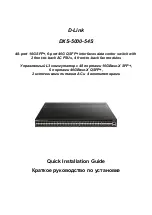
1-10
z
Dual stack is the most direct transition approach. A network node that supports both IPv4 and IPv6
is called a dual stack node. A dual stack node configured with an IPv4 address and an IPv6
address can forward both IPv4 and IPv6 packets. For an upper layer application supporting both
IPv4 and IPv6, either TCP or UDP can be selected at the transport layer, while IPv6 stack is
preferred at the network layer. Dual stack is suitable for communication between IPv4 nodes or
between IPv6 nodes. It is the basis of all transitions technologies. However, it does not solve the IP
address depletion issue because each dual stack node must have a globally unique IP address.
z
Tunneling is an encapsulation technology, which utilizes one network protocol to encapsulate
packets of another network protocol and transfer them over the network. For more information
about tunneling, refer to
Tunneling Configuration
in the
IP Services Volume
.
z
Network Address Port Translation – Protocol Translation (NAPT-PT) is usually applied on a device
between IPv4 and IPv6 networks to translate between IPv4 and IPv6 packets, allowing
communication between IPv4 and IPv6 nodes. It performs IP address translation, and according to
different protocols, performs semantic translation, for packets. This technology is only suitable for
communication between pure IPv4 node and pure IPv6 node.
The S7900E series Ethernet switches do not support NAT-PT.
Protocols and Standards
Protocols and standards related to IPv6 include:
z
RFC 1881: IPv6 Address Allocation Management
z
RFC 1887: An Architecture for IPv6 Unicast Address Allocation
z
RFC 1981: Path MTU Discovery for IP version 6
z
RFC 2375: IPv6 Multicast Address Assignments
z
RFC 2460: Internet Protocol, Version 6 (IPv6) Specification.
z
RFC 2461: Neighbor Discovery for IP Version 6 (IPv6)
z
RFC 2462: IPv6 Stateless Address Autoconfiguration
z
RFC 2463: Internet Control Message Protocol (ICMPv6) for the Internet Protocol Version 6 (IPv6)
Specification
z
RFC 2464: Transmission of IPv6 Packets over Ethernet Networks
z
RFC 2526: Reserved IPv6 Subnet Anycast Addresses
z
RFC 3307: Allocation Guidelines for IPv6 Multicast Addresses
z
RFC 3513: Internet Protocol Version 6 (IPv6) Addressing Architecture
IPv6 Basics Configuration Task List
Complete the following tasks to perform IPv6 basics configuration:
Task
Remarks
Configuring Basic IPv6 Functions
Required
Configuring IPv6 NDP
Optional
Содержание S7906E - Switch
Страница 82: ...1 4 DeviceA interface tunnel 1 DeviceA Tunnel1 service loopback group 1...
Страница 200: ...1 11 DeviceB display vlan dynamic No dynamic vlans exist...
Страница 494: ...ii Displaying and Maintaining Tunneling Configuration 1 45 Troubleshooting Tunneling Configuration 1 45...
Страница 598: ...ii...
Страница 1757: ...4 9...
Страница 1770: ...6 4...
Страница 2017: ...2 11 Figure 2 3 SFTP client interface...
Страница 2062: ...i Table of Contents 1 URPF Configuration 1 1 URPF Overview 1 1 What is URPF 1 1 How URPF Works 1 1 Configuring URPF 1 2...
Страница 2238: ...1 16 DeviceA cfd linktrace service instance 1 mep 1001 target mep 4002...
Страница 2442: ...2 4 Set the interval for sending Syslog or trap messages to 20 seconds Device mac address information interval 20...
















































